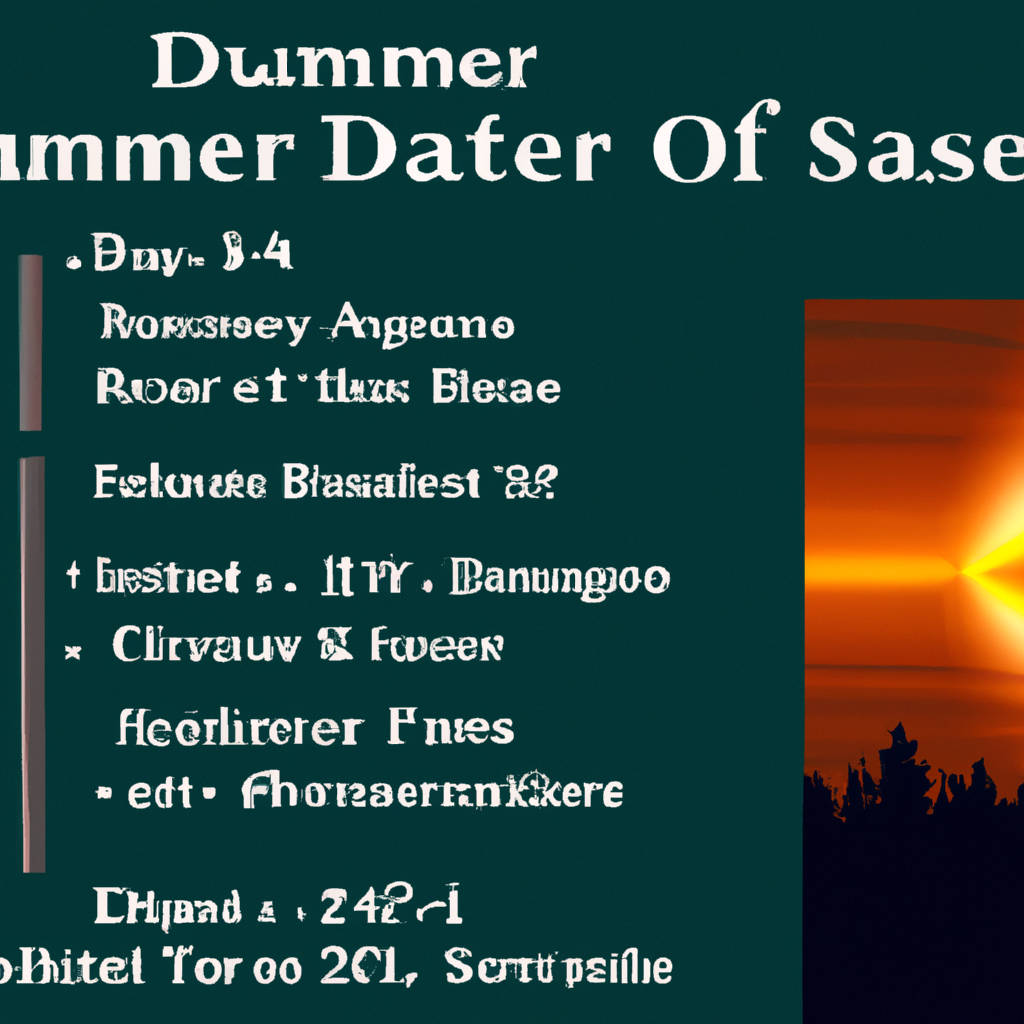The summer solstice of 2024 is a significant celestial event that marks the longest day of the year. It’s precisely the point when the Earth’s tilt towards the Sun is at its maximum, resulting in the most extended period of daylight. Although the exact dates and times may vary depending on the geographical location, it typically occurs between June 20 and 22. In 2024, the Northern Hemisphere is expected to celebrate this seasonal turning point on June 21st. This particular day has been revered across cultures and eras, manifesting in various midsummer traditions. For instance, in many parts of Europe, it’s customary to light bonfires, dance around maypoles, and feast on seasonal produce. Scandinavian countries, known for their prolonged daylight hours during this time, often engage in merriments that last throughout the ‘white nights.’ Meanwhile, in North America, many choose to observe this day by spending time outdoors, appreciating nature’s bounty, and participating in music and art festivals. Another globally recognized tradition is the gathering at Stonehenge in the UK, where thousands converge to witness the sunrise align with the ancient stones. These diverse traditions reflect the shared human fascination and reverence for the sun, the life-giving force, and the changing seasons. The summer solstice is not just a day but a symbol of growth, renewal, and celebration.

When Is the Summer Solstice This Year?
The Summer Solstice, a highly anticipated astronomical event, is when one of the Earth’s poles has its maximum tilt towards the Sun. It happens twice yearly, once in each hemisphere, marking the onset of Summer. This year, the Summer Solstice in the Northern Hemisphere is expected to occur on June 20th, 2022. It’s the day with the longest period of daylight, where the Sun reaches its highest point in the sky at noon, making it seem to stand still. The term ‘solstice’ comes from the Latin words ‘sol’ meaning ‘sun’, and ‘sistere’ meaning ‘to stand still’. Interestingly, despite having the most extended daylight hours, the Summer Solstice is not the day with the earliest sunrise or latest sunset. This discrepancy occurs due to the Earth’s elliptical orbit and its tilt. The exact timing of the Summer Solstice varies each year and between different time zones. It’s a significant event in many cultures, and numerous traditions and celebrations are associated with it. For instance, in the UK, people gather at Stonehenge to see the sunrise align with the stones, a spectacle that happens only on this day. In the Southern Hemisphere, the dates are reversed, with the Summer Solstice occurring in December. Whether you’re planning a special celebration or simply acknowledging the start of a new season, the Summer Solstice is a day to appreciate our connection to the Sun and the natural world around us.
What Occurs During the Summer Solstice?
The Summer Solstice, also known as the June Solstice, is a natural phenomenon that marks the start of summer in the northern hemisphere and is typically observed on either June 20th, 21st, or 22nd. It is the precise moment when the tilt of the Earth’s semi-axis in a given hemisphere is most inclined towards the sun. Consequently, the sun reaches its highest point in the sky, resulting in the longest day and the shortest night of the year. The term ‘solstice’ is derived from the Latin words ‘sol’ (sun) and ‘sistere’ (to stand still), as the sun appears to pause at its zenith before reversing its course.
During the summer solstice, the Earth’s northern or southern hemisphere receives sunlight at the most direct angle of the year, leading to the warmest season. This is a stark contrast to the winter solstice, where the same hemisphere is tilted away from the sun, resulting in the shortest day and longest night of the year.
The summer solstice has been recognized and celebrated by various cultures for centuries, as it is often associated with fertility and the abundance of sunlight. In many cultures, it is marked by festivals, gatherings, rituals, and other celebrations. For instance, the ancient Druids celebrated the summer solstice at Stonehenge, while in Scandinavia, it is celebrated with large bonfires. Additionally, the summer solstice holds significant importance in the field of astronomy, as it helps in the study and understanding of Earth’s rotational axis.
The Summer Solstice is an extraordinary spectacle that showcases the dynamics of our planet’s tilt and orbit. It serves as a reminder of the beautiful intricacies of our planet and the cosmic forces at work that bring about the changes in seasons. Despite the scientific explanations, the summer solstice continues to hold an air of magic and mystery, making it a universally fascinating event.

Traditions Associated with the Summer Solstice
The summer solstice, the longest day of the year, is an event that has been celebrated by various cultures around the world for thousands of years. It usually occurs between June 20th and 22nd in the Northern Hemisphere and between December 20th and 23rd in the Southern Hemisphere. Different cultures have their own unique traditions associated with this astronomical event.
In Sweden, people celebrate the summer solstice, or Midsommar, with a feast and dancing around a maypole. The day is considered one of the most important holidays in the country and is often accompanied by singing traditional songs. In contrast, the ancient Druids celebrated the summer solstice at Stonehenge in England, where they performed rituals to honor the sun. This tradition is still alive today, with modern Druids gathering at Stonehenge to watch the sunrise on the longest day of the year.
In China, the summer solstice is associated with the yin and the yang. The philosophy dictates that the summer solstice is the highest point of yang, the force that represents light and warmth, which starts to retreat and give way to yin, the force representing darkness and cold, after the solstice. They celebrate with the Dragon Boat Festival, a tradition that involves racing dragon boats and eating zongzi, a type of sticky rice dumpling.
In North America, some Native American tribes, such as the Hopi in Arizona, perform traditional dances and rituals to ensure a successful harvest. They wear traditional costumes and masks and perform dances that have been passed down through generations. On the other side of the world, in Russia, the summer solstice is known as Ivan Kupala Day, which combines elements of pagan and Christian traditions, including bathing in holy water and leaping over fires.
Regardless of where it’s celebrated, the summer solstice represents a time of change, renewal, and celebration, a time to honor the sun and its life-giving power.
Ways to Celebrate the Summer Solstice
The Summer Solstice, also known as the longest day of the year, is a unique event that deserves special celebration. There are many different ways to honor this occasion, depending on one’s personal preferences and cultural background. One popular method is to host a backyard barbecue or picnic, inviting friends and family to enjoy the extended daylight hours. This provides an opportunity to spend quality time together, cook delicious food, and engage in outdoor activities. Another option is to organize a beach or camping trip to truly immerse oneself in nature. The Summer Solstice is a perfect time to take advantage of the great outdoors, whether it be swimming, hiking, or simply lounging in the sun.
For those with a more spiritual inclination, the Summer Solstice holds significant meaning in many cultures and religions. Participating in a Solstice ritual or ceremony, such as yoga, meditation, or a communal bonfire, can be a profoundly moving experience. These rituals often involve reflecting on personal growth and setting intentions for the upcoming season.
Others may choose to celebrate the Summer Solstice by visiting a local festival or event. Many communities hold special events to mark the occasion, such as music concerts, art exhibits, or food markets. These public celebrations can be a great way to connect with the local community and enjoy the vibrant energy of the season.
Alternatively, one could use the Summer Solstice as an excuse to explore a new hobby or activity. With the extra daylight, there’s plenty of time to try something new. This could be anything from gardening, to painting, to learning a new instrument.
No matter how you choose to celebrate the Summer Solstice, the most important thing is to appreciate the beauty of nature and the joy of summer. Whether it’s spending time with loved ones, enjoying a favorite activity, or simply basking in the sunlight, the Summer Solstice is a day to be savored.

The Significance of Stonehenge During the Summer Solstice
Stonehenge, located in Wiltshire, England, holds tremendous cultural and historical significance, particularly during the Summer Solstice. This prehistoric monument, built in various stages from 3000 BC to 1600 BC, is aligned on a sight-line that points to the Summer Solstice sunrise, a characteristic that has been associated with many ancient and sacred sites. The Summer Solstice, the longest day of the year, is a time when the sun reaches its highest point in the sky, symbolizing a period of abundance, growth, and renewal.
For centuries, Stonehenge has served as a spiritual center during this period, attracting thousands of visitors, including modern-day Druids, Pagans, and those simply intrigued by its mystique. It is believed that ancient societies may have used Stonehenge as a celestial calendar, tracking the sun’s movement to predict the changing of seasons.
During the Summer Solstice, the rising sun appears behind one of the main stones, creating a breathtaking spectacle as the first rays of light strike the center of the monument, illuminating it in a golden hue. This extraordinary alignment between the monument and the sun creates a powerful connection between the earth, the sun, and humanity’s ancient past.
This event is not only a visual spectacle but also a spiritual gathering. It is a time when people from all walks of life come together to celebrate the power of the sun, the changing of the seasons, and the enduring mystery of this ancient monument. The gathering at Stonehenge during the Summer Solstice is a testament to the enduring appeal and significance of this prehistoric site, reminding us of our deep-rooted connection with nature and the cosmos. Whether it was constructed as a sacred site, a celestial calendar, or both, the allure of Stonehenge during the Summer Solstice continues to captivate and inspire, bridging the gap between our present and our distant past.
The Connection Between the Summer Solstice and Midsummer
The Summer Solstice and Midsummer are intrinsically linked, both alluding to the same astronomical event, but with different cultural interpretations. The summer solstice, the longest day of the year, typically falls on June 21st in the Northern Hemisphere. This is the day when the sun reaches its highest point in the sky, resulting in prolonged daylight. Midsummer, on the other hand, is a traditional holiday celebrated in many cultures and typically marks the middle of summer. Although the exact date can vary, many cultures celebrate it around the time of the summer solstice.
Historically, the summer solstice has held significant importance in various societies, symbolizing the power of the sun, fertility, and the bounty of the coming harvest. It was, and still is, a time for communities to come together in celebration. Many ancient monuments, such as Stonehenge in England, have been linked to the summer solstice, showing the importance of this celestial event throughout history.
Midsummer, meanwhile, is a celebration that often incorporates elements of ancient solstice rituals. For instance, in Scandinavian countries, it’s a major holiday where people gather to celebrate with bonfires, dancing, and feasting, reminiscent of ancient solstice celebrations. Similarly, in the United Kingdom, people flock to Stonehenge to watch the sunrise on the summer solstice, a tradition that has been revived in recent decades.
Despite the different terminologies and cultural practices, the connection between the summer solstice and Midsummer is clear. They both celebrate the sun at its zenith and the joy of the summer season. Whether it’s watching the sunrise at Stonehenge, dancing around a bonfire in Sweden, or simply enjoying the longest day of the year, these traditions and celebrations highlight our enduring fascination with and appreciation of the natural world.
